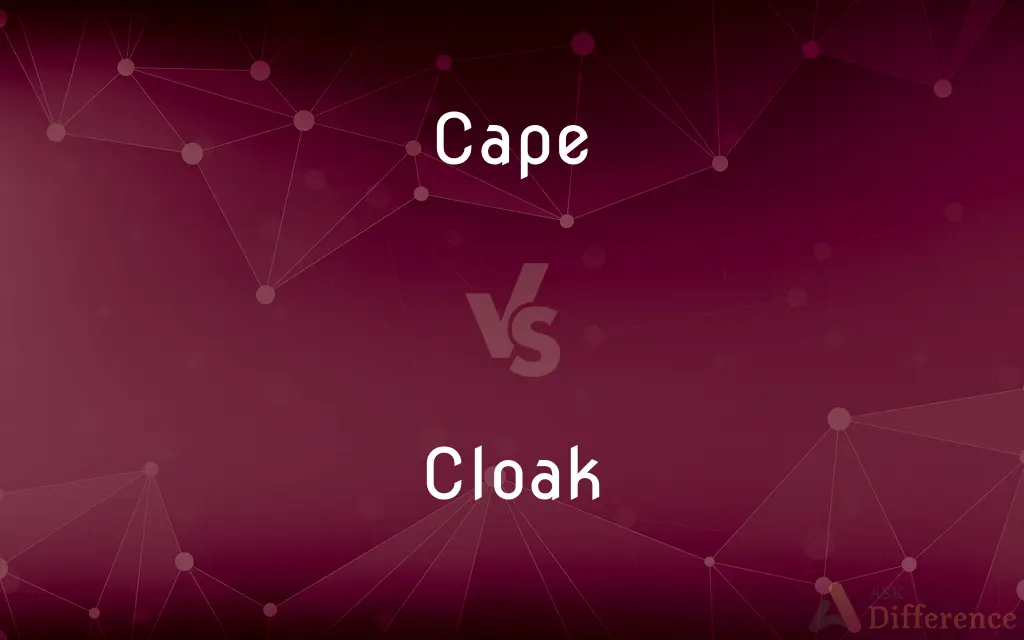Cape vs. Cloak — What's the Difference?
By Tayyaba Rehman & Fiza Rafique — Updated on September 10, 2023
A cape is a sleeveless garment that drapes over the shoulders and hangs down the back, often fastening at the neck. A cloak is a similar garment but typically has a hood and may envelop the wearer more fully.

Difference Between Cape and Cloak
Table of Contents
ADVERTISEMENT
Key Differences
A cape is generally a sleeveless piece of fabric that attaches around the neck and drapes down the back. It is often decorative and can come in various lengths, from short capes that just cover the shoulders to long ones that go down to the ankles. Cloaks, on the other hand, are also sleeveless but are more utilitarian and often come with a hood. They are designed to offer more coverage and are usually longer, enveloping the wearer more fully.
The primary purpose of a cape is often fashion. In modern times, capes are mostly seen as stylish accessories or part of specific uniforms, like those of superheroes or ceremonial garments. Cloaks serve a more functional purpose, primarily providing warmth and sometimes anonymity. They are more commonly seen in historical or fantasy settings where they serve as protective garments against the elements.
While capes are almost always open in the front, allowing the front of the wearer's outfit to show, cloaks can be open or closed. A cloak often has the capability of being fastened in the front to provide more coverage and protection, which is not a feature commonly found in capes. Cloaks are generally designed to be more practical, while capes are often more concerned with aesthetics.
In terms of material, both capes and cloaks can be made of a variety of fabrics, including but not limited to wool, cotton, and synthetic blends. However, cloaks are more likely to be made of heavier, more durable materials to fulfill their protective role, while capes are often made of lighter, more luxurious fabrics to enhance their decorative appeal.
Comparison Chart
Purpose
More decorative
More functional
ADVERTISEMENT
Coverage
Less coverage
More coverage
Hood
Rarely has a hood
Often has a hood
Fastening
Usually at neck
Can fasten in front
Material
Lighter fabrics
Heavier fabrics
Compare with Definitions
Cape
A cape is a sleeveless garment hanging from the neck.
She wore a red silk cape to the opera.
Cloak
A cloak is a sleeveless garment that provides more coverage.
She wrapped herself in a woolen cloak to keep warm.
Cape
A cape can be part of a uniform or ceremonial dress.
The graduation cape signified their academic achievement.
Cloak
A cloak often includes a hood.
The cloak's hood concealed his identity.
Cape
A cape is often a decorative piece of clothing.
The superhero's cape flowed dramatically in the wind.
Cloak
A cloak is typically longer than a cape.
The cloak trailed behind her as she walked.
Cape
A cape usually fastens at the neck.
She fastened her cape with a jeweled brooch.
Cloak
A cloak is generally more functional and less decorative.
The soldier wore a cloak for warmth and camouflage.
Cape
A cape can come in various lengths.
The short cape added flair to her outfit.
Cloak
A cloak can fasten in the front for added protection.
He fastened his cloak to shield against the wind.
Cape
A cape is a sleeveless outer garment which drapes the wearer's back, arms, and chest, and connects at the neck.
Cloak
A cloak is a type of loose garment that is worn over indoor clothing and serves the same purpose as an overcoat; it protects the wearer from the cold, rain or wind for example, or it may form part of a fashionable outfit or uniform. Cloaks have been used by myriad historic societies; many climates favor wearing a full-body garment which is easily removed and does not constrain the wearer with sleeves.
Cape
A sleeveless cloak, typically a short one
He was wearing a flowing cape
Cloak
A sleeveless outdoor overgarment that hangs loosely from the shoulders
He threw his cloak about him
Cape
The pelt from the head and neck of an animal, for preparation as a hunting trophy
The hair on a cape for the taxidermist can spoil in warm weather
Cloak
A cloakroom
Ground-floor accommodation comprises hall, cloaks, lounge, kitchen
Cape
A headland or promontory
We could see the island from the cape
Cloak
Dress in a cloak
They sat cloaked and hooded
Cape
(in bullfighting) taunt (the bull) by flourishing a cape
The film shows a man expertly caping a charging bull
Cloak
A long, loose outer garment, usually having a hood and no sleeves.
Cape
Skin the head and neck of (an animal) to prepare a hunting trophy.
Cloak
Something that covers or conceals
A cloak of secrecy.
Cape
A sleeveless outer garment fastened at the throat and worn hanging over the shoulders.
Cloak
To cover or conceal with a cloak or something that acts like a cloak
Mist that cloaks the mountains.
Cape
A brightly colored cloth used in maneuvering the bull in a bullfight; a capote or muleta.
Cloak
A long outer garment worn over the shoulders covering the back; a cape, often with a hood.
Cape
A point or head of land projecting into a body of water.
Cloak
A blanket-like covering, often metaphorical.
Night hid her movements with its cloak of darkness.
Cape
To maneuver (the bull) by means of a cape in a bullfight.
Cloak
(figurative) That which conceals; a disguise or pretext.
RQ:South Twelve Sermons
Cape
(geography) A piece or point of land, extending beyond the adjacent coast into a sea or lake; a promontory; a headland.
Cloak
(Internet) A text replacement for an IRC user's hostname or IP address, making the user less identifiable.
Cape
A sleeveless garment or part of a garment, hanging from the neck over the back, arms, and shoulders.
Cloak
(transitive) To cover as with a cloak.
Cape
(slang) A superhero.
Cloak
To cover up, hide or conceal.
Cape
To incite or attract (a bull) to charge a certain direction, by waving a cape.
Cloak
To render or become invisible via futuristic technology.
The ship cloaked before entering the enemy sector of space.
Cape
(nautical) To head or point; to keep a course.
The ship capes southwest by south.
Cloak
A loose outer garment, extending from the neck downwards, and commonly without sleeves. It is longer than a cape, and is worn both by men and by women.
Cape
To skin an animal, particularly a deer.
Cloak
That which conceals; a disguise or pretext; an excuse; a fair pretense; a mask; a cover.
No man is esteemed any ways considerable for policy who wears religion otherwise than as a cloak.
Cape
To defend or praise, especially that which is unworthy.
Cloak
To cover with, or as with, a cloak; hence, to hide or conceal.
Now glooming sadly, so to cloak her matter.
Cape
(obsolete) To look for, search after.
Cloak
Anything that covers or conceals
Cape
To gaze or stare.
The captain just caped mindlessly into the distance as his ship was hit by volley after volley.
Cloak
A loose outer garment
Cape
A piece or point of land, extending beyond the adjacent coast into the sea or a lake; a promontory; a headland.
Cloak
Hide under a false appearance;
He masked his disappointment
Cape
A sleeveless garment or part of a garment, hanging from the neck over the back, arms, and shoulders, but not reaching below the hips. See Cloak.
Cape
To head or point; to keep a course; as, the ship capes southwest by south.
Cape
To gape.
Cape
A strip of land projecting into a body of water
Cape
A sleeveless garment like a cloak but shorter
Common Curiosities
Is a Cloak always heavy?
No, but cloaks are often made of heavier materials for added protection.
Are all Capes short?
No, capes can come in various lengths, from short to long.
Can a Cape be functional?
While capes are generally more decorative, some are designed for specific functional roles.
Who typically wears a Cloak?
Cloaks are usually worn for protection against the elements and can be seen in historical or fantasy settings.
Do all Cloaks have hoods?
No, but it's common for cloaks to have hoods for added coverage.
Can a Cape have a hood?
While rare, some capes do come with hoods.
Can a Cloak be open in the front?
A cloak can be either open or fastened in the front for added coverage.
What are capes made of?
Capes can be made of various materials, including silk, cotton, and synthetic blends.
Can men wear Capes?
Yes, capes can be worn by individuals of any gender.
Who typically wears a Cape?
Capes are often worn as fashion accessories or as part of ceremonial or fantasy costumes.
Can a Cloak be decorative?
Yes, some cloaks are designed with decorative elements, but they are generally more functional.
Is a Cape always open in the front?
Most capes are open in the front to showcase the wearer's outfit.
What are cloaks made of?
Cloaks are generally made of heavier materials like wool or thick cotton.
Can men wear Cloaks?
Yes, cloaks are also gender-neutral and can be worn by anyone.
Are Capes and Cloaks the same?
While similar, capes and cloaks have differences in purpose, coverage, and design features.
Share Your Discovery

Previous Comparison
Synthesis vs. Biosynthesis
Next Comparison
Bunny vs. RabbitAuthor Spotlight
Written by
Tayyaba RehmanTayyaba Rehman is a distinguished writer, currently serving as a primary contributor to askdifference.com. As a researcher in semantics and etymology, Tayyaba's passion for the complexity of languages and their distinctions has found a perfect home on the platform. Tayyaba delves into the intricacies of language, distinguishing between commonly confused words and phrases, thereby providing clarity for readers worldwide.
Co-written by
Fiza RafiqueFiza Rafique is a skilled content writer at AskDifference.com, where she meticulously refines and enhances written pieces. Drawing from her vast editorial expertise, Fiza ensures clarity, accuracy, and precision in every article. Passionate about language, she continually seeks to elevate the quality of content for readers worldwide.
















































